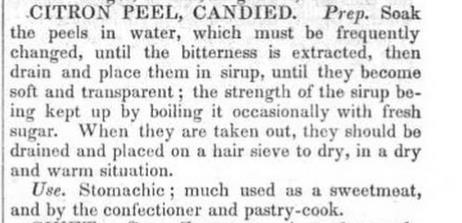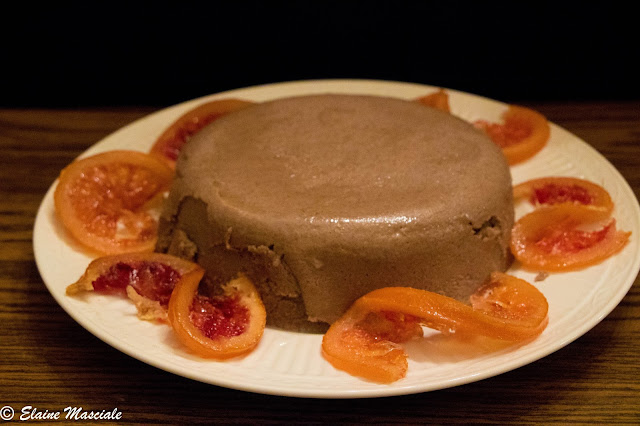Candied Orange Peel
It's January and that means decreased levels of sunlight, lots of cold, and an upswing in illness across the board. Christmas decorations are down and put away, leaving surroundings duller and grayer. It's also peak time for citrus (this assumes you remember when fruits and vegetables were sold seasonally in the grocery stores).
We have been eating a lot of oranges this winter. I have been collecting the peels in a water-filled plastic zip top bag in our refrigerator, When the bag reaches the desired level, it is time to make candied orange peel. There is no hard or fast level - it totally depends upon how large a batch you want to make at a time and if you have the time free for candying.
Let's start with the historic recipe
To actually make these, I used some modern techniques.
Place the orange peels in a heavy-bottomed saucepan with enough water to cover them generously. Bring the water to a boil. After roughly 30 seconds, drain the boiling water and refill the pot with cold water. You could also drain the peels into a colander, rinse well with cold water, and return to the pot of cold water. Do this two more times, for a total of 3 times. Not only does this process help remove the bitterness, but it cooks the peel and softens the pith. The period recipe doesn't suggest blanching as part of the process, but just soaking and changing out the water would take a long time.
Remove one piece of peel and place it on a hard surface, such as a cutting board. With the edge of a teaspoon, carefully but firmly scrape out some of the softened pith. I find I prefer to leave a layer of the pith, the few times I have been able to scrape all the way down to the peel my candied peel has been more brittle. Repeat until all the peels have been scraped. Discard the pith.
Cut the scraped peels into thin strips. The thickness is your personal preference. I have found I prefer the strips to be fairly thin (1/8"), but there is nothing wrong with thicker peels (1/4"). Don't discard any uneven or small bits - they will candy just as well.
In the empty pot, place 3 c of water and 3 c of white sugar, and heat to dissolve. Add the peel. The sugar should totally cover the peel. Bring to a boil, reduce the heat, and let simmer for 60 min. There is debate on how long this candying should take, with some sources suggesting just until the peel is tender and other suggesting 90 min, with the sugar syrup being greatly reduced.
Remove the peel from the pot in small batches, using a slotted spoon. Let the sugar syrup drip back into the pot before you move it to the next stage. Set up a drying rack over a baking sheet so the sugar syrup doesn't drip onto your counter or table. You can either put the peel on a plate, transfer it piece by piece to a drying rack and then sprinkle it with sugar, or you can do what I do. I spread a layer of sugar on a plate or small baking pan, put in the peel, then stir the peel with a fork to coat it with the sugar. After the peel is coated with sugar, transfer it piece by piece to the drying rack.
When dry, place the peel in a closed container and store in a cool, dry place. I have found I prefer candied peel after it ages a while. Of course, it can be eaten as soon as it has dried - and, well, while it is drying. It's hard to resist! There does not seem to be an expiration for candied peel as long as it is stored properly (mold indicating improper storage).
The same process can be used for other citrus peels: lemons, grapefruit, and limes. Limes are almost impossible to scrape out, the skins being so thin, that it is easier to simply skip that step The limes will definitely have a bitter lime bite to them! I would recommend not candying more than one type of peel at a time because the flavors tend to cross in the blanching process.
The orange sugar syrup can be stored in the refrigerator for other uses or you can let it crystalize on shallow pans and use the sugar for other purposes.
Place orange peels in a large, heavy-bottom sauce pot with enough cold water to cover generously. Bring to a boil. After roughly 30 seconds, drain the peel and rinse with cold water. Repeat the process 2 more times, for a total of 3 blanching cycles.
Leaving the peel in the cold water, carefully scrape some pith from each piece of peel. Discard the pith.
Cut the peels into strips of desired thickness.
Place 3 c of water and 3 c of sugar in the same pot. Heat to dissolve the sugar. Add the strips of peel. Bring to a boil, reduce the heat, and let cook gently for roughly 1 hr.
Place a drying rack in a shallow baking pan.
Using a slotted spoon, remove the peel from the sugar syrup in small batches, letting the syrup drip back into the pot before proceeding. Either spread a shallow layer of sugar on a plate and dredge the peel in small batches, refreshing the sugar as needed and carefully spreading on the drying rack, or spread the peel directly on the rack in a single layer and then sprinkle generously with sugar, turning the peel to get both sides, Let dry.
Store in a closed container in a cool, dry place.
We have been eating a lot of oranges this winter. I have been collecting the peels in a water-filled plastic zip top bag in our refrigerator, When the bag reaches the desired level, it is time to make candied orange peel. There is no hard or fast level - it totally depends upon how large a batch you want to make at a time and if you have the time free for candying.
Historic Recipe
Let's start with the historic recipe
 |
| (A Cyclopaedia of Six Thousand Practical Receipts, Arnold James Cooley, New York, 1856) |
How to Make It!
To actually make these, I used some modern techniques.
Place the orange peels in a heavy-bottomed saucepan with enough water to cover them generously. Bring the water to a boil. After roughly 30 seconds, drain the boiling water and refill the pot with cold water. You could also drain the peels into a colander, rinse well with cold water, and return to the pot of cold water. Do this two more times, for a total of 3 times. Not only does this process help remove the bitterness, but it cooks the peel and softens the pith. The period recipe doesn't suggest blanching as part of the process, but just soaking and changing out the water would take a long time.
 |
| Orange peel under going the blanching process |
Remove one piece of peel and place it on a hard surface, such as a cutting board. With the edge of a teaspoon, carefully but firmly scrape out some of the softened pith. I find I prefer to leave a layer of the pith, the few times I have been able to scrape all the way down to the peel my candied peel has been more brittle. Repeat until all the peels have been scraped. Discard the pith.
 |
| Orange peels with the pith scraped out |
Cut the scraped peels into thin strips. The thickness is your personal preference. I have found I prefer the strips to be fairly thin (1/8"), but there is nothing wrong with thicker peels (1/4"). Don't discard any uneven or small bits - they will candy just as well.
Remove the peel from the pot in small batches, using a slotted spoon. Let the sugar syrup drip back into the pot before you move it to the next stage. Set up a drying rack over a baking sheet so the sugar syrup doesn't drip onto your counter or table. You can either put the peel on a plate, transfer it piece by piece to a drying rack and then sprinkle it with sugar, or you can do what I do. I spread a layer of sugar on a plate or small baking pan, put in the peel, then stir the peel with a fork to coat it with the sugar. After the peel is coated with sugar, transfer it piece by piece to the drying rack.
 |
| Candied orange peel, dredged in sugar, drying on the rack. These are my thicker version (about 1/4" wide) |
When dry, place the peel in a closed container and store in a cool, dry place. I have found I prefer candied peel after it ages a while. Of course, it can be eaten as soon as it has dried - and, well, while it is drying. It's hard to resist! There does not seem to be an expiration for candied peel as long as it is stored properly (mold indicating improper storage).
 |
| dried orange peel, ready to be packed away! So yummy! |
The same process can be used for other citrus peels: lemons, grapefruit, and limes. Limes are almost impossible to scrape out, the skins being so thin, that it is easier to simply skip that step The limes will definitely have a bitter lime bite to them! I would recommend not candying more than one type of peel at a time because the flavors tend to cross in the blanching process.
 |
| candied lime peel |
The orange sugar syrup can be stored in the refrigerator for other uses or you can let it crystalize on shallow pans and use the sugar for other purposes.
The Recipe Summarized
Place orange peels in a large, heavy-bottom sauce pot with enough cold water to cover generously. Bring to a boil. After roughly 30 seconds, drain the peel and rinse with cold water. Repeat the process 2 more times, for a total of 3 blanching cycles.
Leaving the peel in the cold water, carefully scrape some pith from each piece of peel. Discard the pith.
Cut the peels into strips of desired thickness.
Place 3 c of water and 3 c of sugar in the same pot. Heat to dissolve the sugar. Add the strips of peel. Bring to a boil, reduce the heat, and let cook gently for roughly 1 hr.
Place a drying rack in a shallow baking pan.
Using a slotted spoon, remove the peel from the sugar syrup in small batches, letting the syrup drip back into the pot before proceeding. Either spread a shallow layer of sugar on a plate and dredge the peel in small batches, refreshing the sugar as needed and carefully spreading on the drying rack, or spread the peel directly on the rack in a single layer and then sprinkle generously with sugar, turning the peel to get both sides, Let dry.
Store in a closed container in a cool, dry place.



Comments
Post a Comment